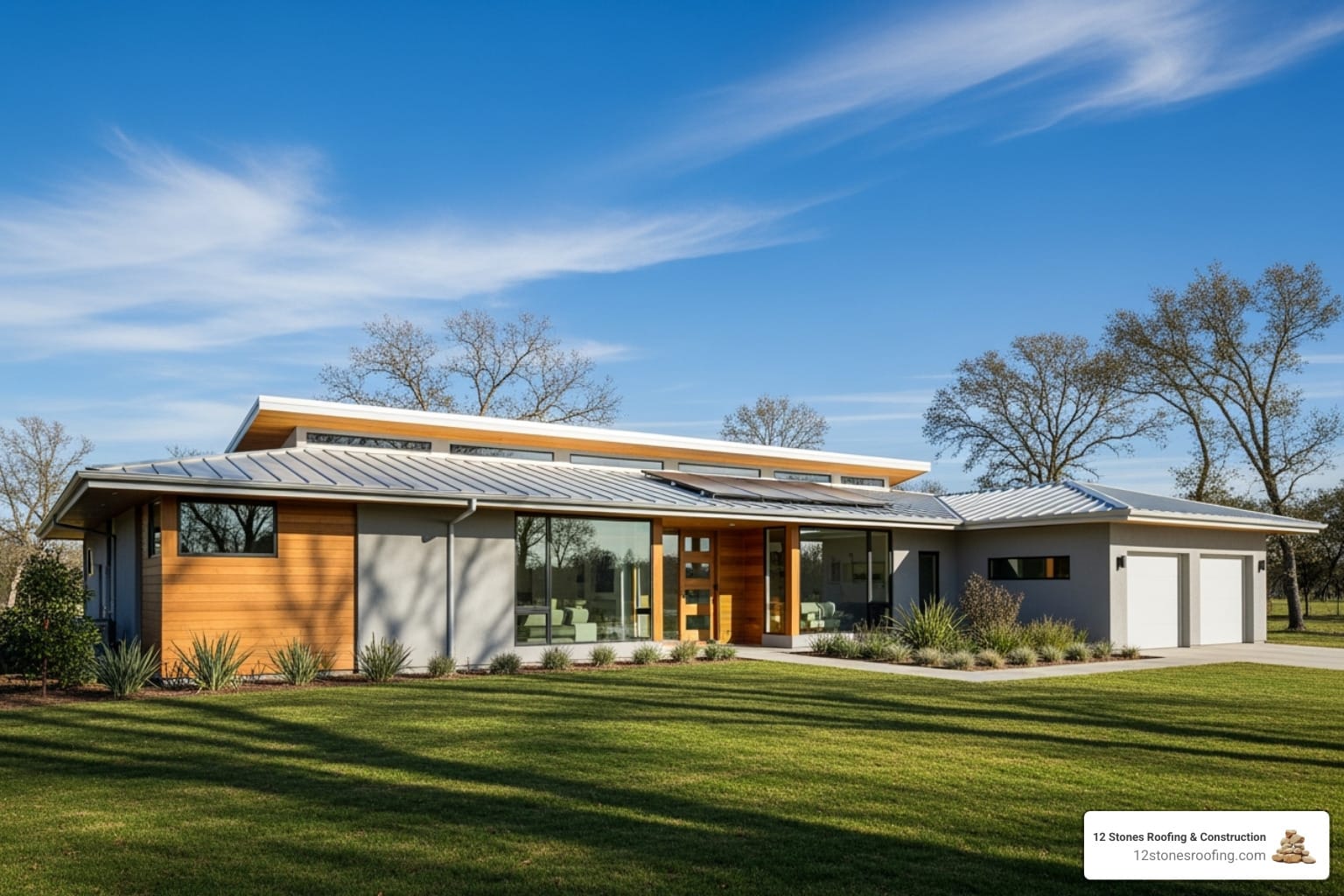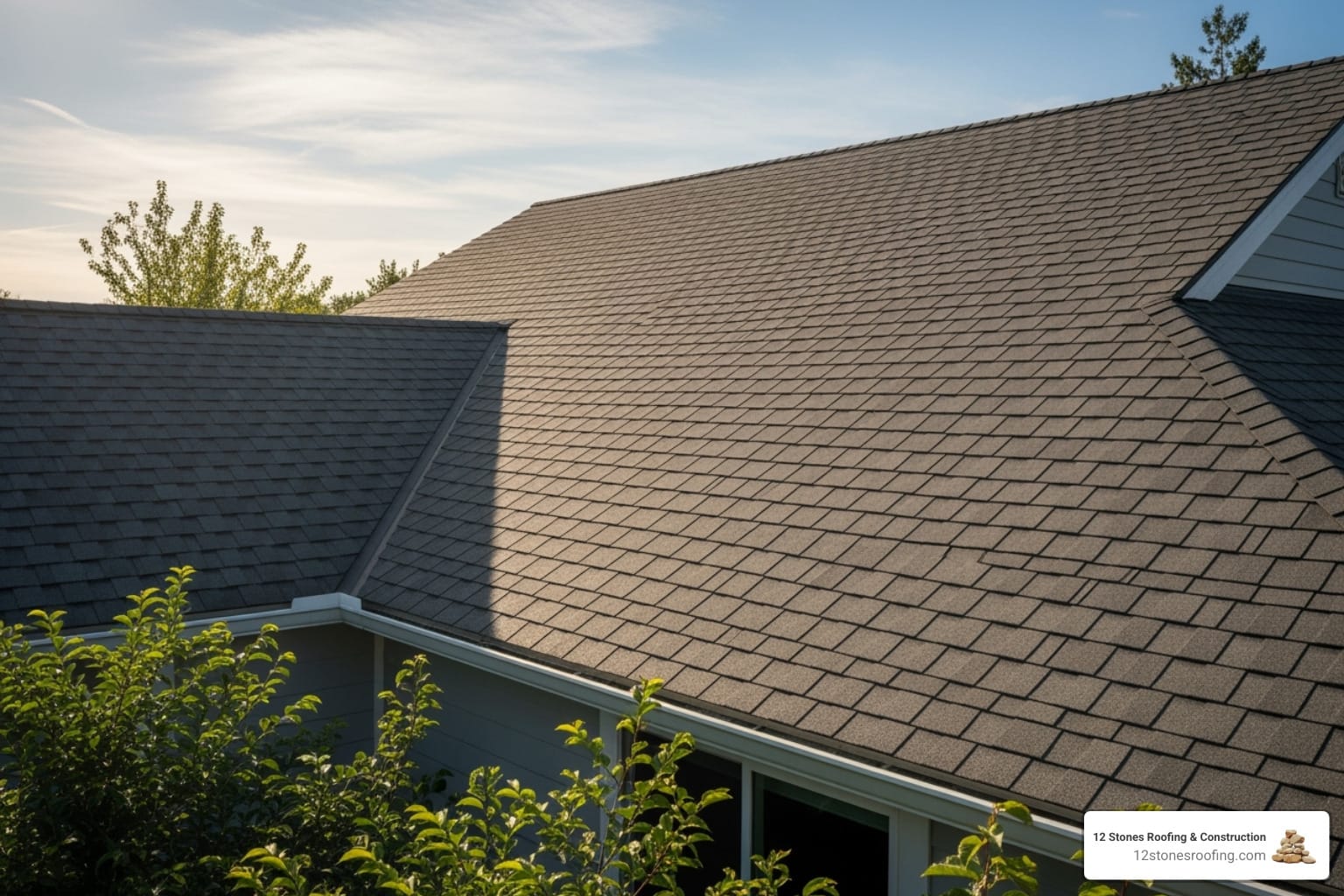Why Immediate Action After a Hailstorm Can Save You Thousands
A hail damage roof inspection is crucial after any storm to identify issues that could lead to costly leaks, structural problems, and voided warranties. For Texas homeowners, understanding the risks and knowing when to seek professional roofing services is the first step in protecting your property. Hail damage isn’t always visible from the ground, and what you can’t see can cause significant harm over time.
Key Signs of Hail Damage:
- Dented gutters and downspouts
- Granules in gutters or on the ground
- Bruised or cracked shingles
- Damaged roof vents and flashing
- Interior water stains
Ignoring potential damage can lead to progressive water leaks, mold growth, and structural compromise, costing far more than initial repairs. Even worse, most insurance policies require claims to be filed within a specific timeframe, often one year from the storm date. The hidden danger is functional damage that reduces your roof’s ability to shed water. This may not cause immediate leaks but will shorten your roof’s lifespan and can void manufacturer warranties.
While you can spot obvious signs, a professional roof inspection is essential for identifying hidden damage. Early detection is the key to saving thousands in future repairs and ensuring your home remains secure.
The Anatomy of a Hailstorm: How Weather and Roof Type Dictate Damage
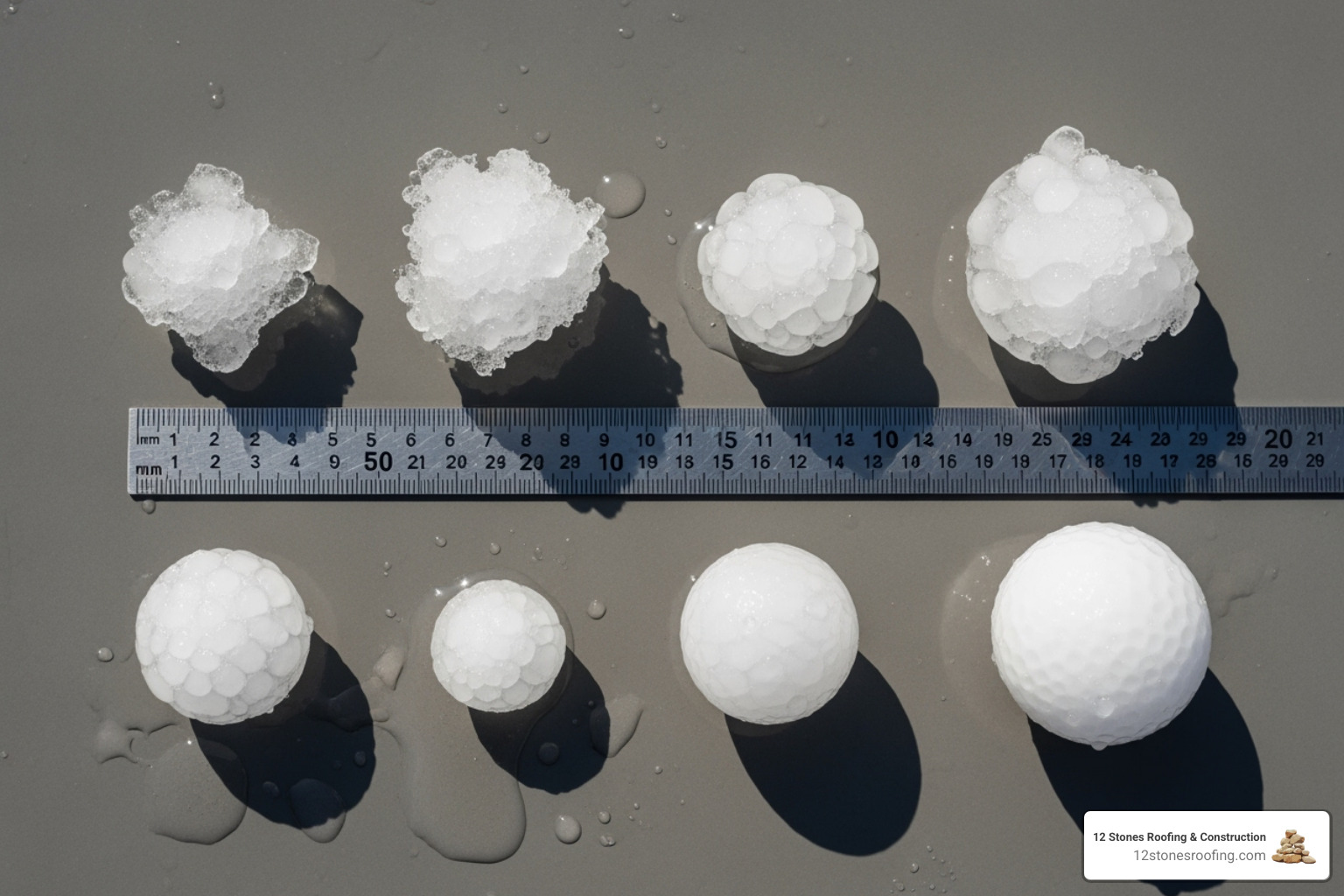
Understanding how hail forms helps clarify why a hail damage roof inspection is so critical. Hailstones begin as tiny particles inside powerful thunderstorms, where strong updrafts toss them into the freezing upper atmosphere. According to the National Severe Storms Laboratory, they accumulate layers of ice as they are repeatedly lifted and dropped, growing until they are heavy enough to fall as roof-damaging projectiles.
How Hail Size and Storm Conditions Affect Your Roof
The severity of hail damage depends on more than just size. Wind speed drives hailstones at damaging angles, while storm duration determines the extent of the impact. The impact energy increases dramatically with size. While pea-sized hail may be harmless, 1-inch hail damage (quarter-sized) can bruise shingle underlayment and cause significant granule loss. At 1.5-inch hail damage (golf ball-sized), the destruction becomes severe, fracturing fiberglass mats and compromising the roof’s integrity.
Research shows that 1-inch diameter hailstones are the typical threshold for damaging common asphalt shingles. However, older or multi-layered roofs can suffer damage from smaller, wind-driven hail.
| Hailstone Size | Asphalt Shingles | Metal Panels | Clay Tiles |
|---|---|---|---|
| ¾” (Dime) | May dislodge granules, especially on older shingles. | Minor cosmetic dents. | Typically no damage. |
| 1″ (Quarter) | Can cause bruising to shingle underlayment, significant granule loss. | Noticeable dents, possible paint chips. | Low risk of cracks. |
| 1¼” (Half Dollar) | Bruising, cracks, exposed fiberglass mat. | Significant dents, potential punctures on thinner gauges. | Higher risk of cracks or shattering. |
| 1½” (Golf Ball) | Fractured fiberglass mat, weakened self-seal strip. | Deep dents, potential for structural deformation. | High risk of cracks or shattering. |
| 2″+ (Tennis Ball) | Severe damage, widespread fracturing, potential penetration. | Major deformation, punctures. | Severe shattering. |
Factors That Increase Your Roof’s Vulnerability
Not all roofs are equally resilient. Roof age is a primary factor; shingles become brittle over time from sun exposure and are less able to absorb impact. Material type also matters. While standard asphalt shingles are common, thicker laminated shingles offer more resistance than thinner three-tab shingles. A second layer of shingles can also sustain more damage due to less solid support underneath. Finally, a lack of routine roof maintenance creates weak points that hail can easily exploit, turning minor impacts into major problems.
Your Post-Storm Checklist: Identifying Hail Damage from the Ground Up
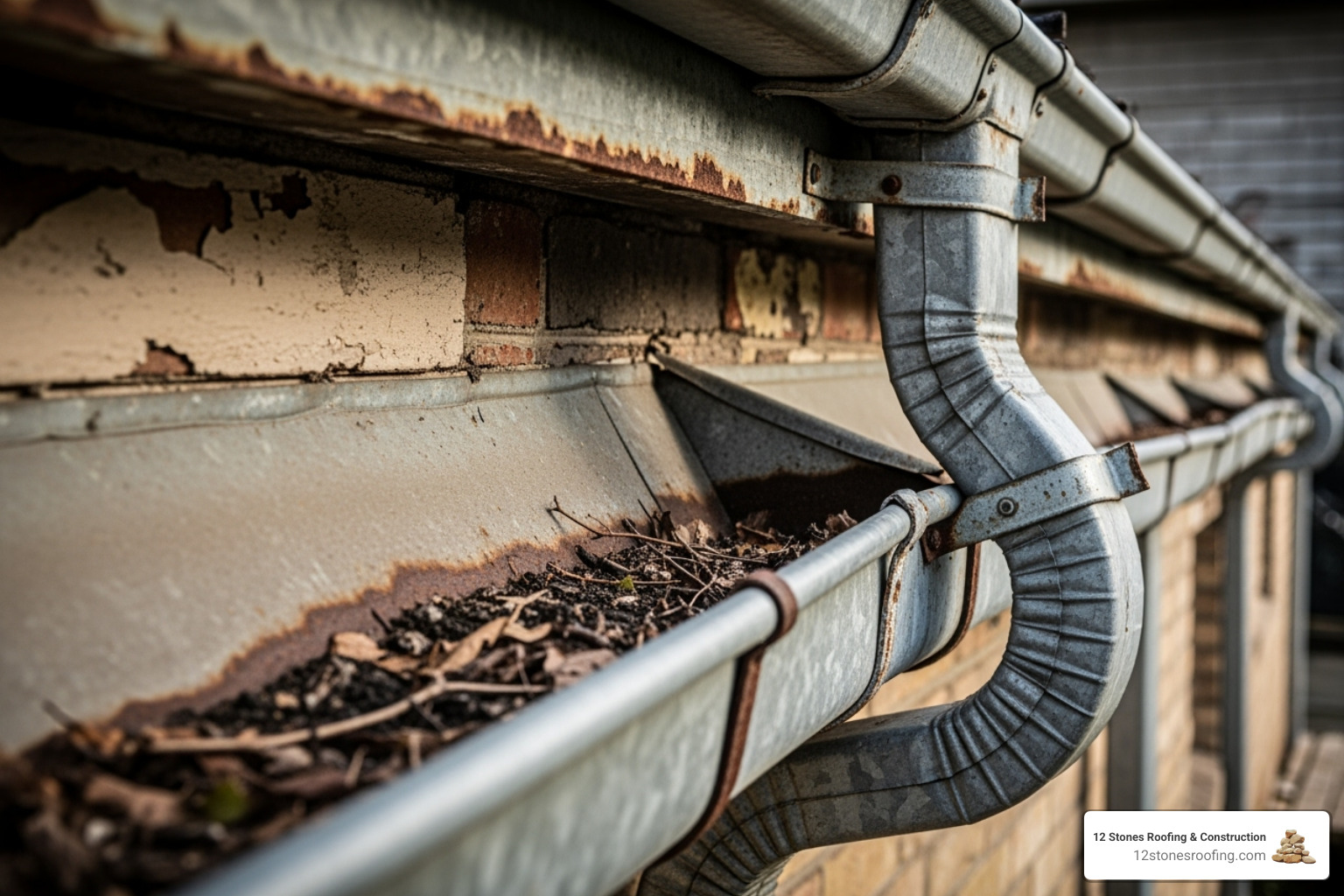
After a hailstorm, your first priority is safety. We never advise getting on your roof without proper safety gear and experience. A professional can spot damage you might miss, but you can perform a preliminary assessment from the ground.
Spotting Collateral Damage Around Your Property
Hail often leaves clues beyond your roof. This “collateral damage” indicates your roof likely sustained damage as well. Look for:
- Dented Gutters, Downspouts, and AC Units: Check metal surfaces for dents and dings.
- Chipped or Cracked Siding: Vinyl siding may crack, while aluminum siding can dent.
- Damaged Fences and Decks: Look for fresh scrapes on wood fencing or chipped paint on decks.
- Torn Window Screens or Cracked Mailboxes: These are common signs of hail impact.
- Damaged Outdoor Items: Check furniture, grills, and light fixtures for dents or cracks.
Finding these signs strongly suggests your roof was in the hail’s path. For a more detailed list, you can review a big checklist of items that point to roof hail damage.
A Homeowner’s Guide to a Safe Hail Damage Roof Inspection
From the ground, use binoculars to look for these key indicators on your roof:
- Granule Loss: Check for shingle granules in gutters or at the base of downspouts. This can indicate impact damage.
- Shingle Bruising or Dimples: Look for soft spots or indentations on shingles where granules are missing. A true bruise will feel soft, like a bruised apple.
- Cracks and Splits: Hail can cause visible cracks, especially on older shingles.
- Exposed Fiberglass Mat: Severe impacts can knock off granules and expose the underlying mat, a clear sign of functional damage.
- What is NOT Hail Damage: Hail does not leave scratches or creases. This distinction is vital for insurance claims.
If your ground-level assessment reveals any of these signs, it’s time to call a professional for a thorough hail damage roof inspection.
The Professional Hail Damage Roof Inspection: What to Expect
A professional hail damage roof inspection is a systematic process to protect you from costly future surprises. While some companies charge for this service, many reputable roofers offer inspections at no charge when storm damage is suspected. A trained professional can spot subtle signs of damage that are invisible from the ground but could compromise your roof’s integrity.
Functional vs. Cosmetic Damage: What Your Insurance Cares About
This distinction is crucial for the insurance claims process. Functional damage reduces your roof’s ability to shed water or shortens its expected lifespan. This includes fractured fiberglass mats, punctures, or significant bruising. Cosmetic damage, on the other hand, affects appearance without impacting performance, such as minor dents on metal vents. In 2013, the American Association of Insurance Services introduced a “Cosmetic Damage Exclusion,” allowing insurers to deny coverage for purely cosmetic issues. A qualified professional can help differentiate between the two, which is vital for your roofing insurance claims process.
The Steps of a Professional Hail Damage Roof Inspection
A thorough inspection follows a clear process to ensure nothing is missed:
- Initial Consultation: We discuss the storm date and your concerns to establish context.
- Exterior Assessment: We examine the entire property for collateral damage to gauge the storm’s severity.
- On-Roof Analysis: Using safety equipment, we mark “test squares” (10×10 ft sections) on each slope to count hail impacts and identify bruising, fracturing, and other damage.
- Attic and Interior Check: We look for signs of water penetration, such as stains on decking or wet insulation.
- Photo Documentation: We take high-resolution photos and videos of all damage to support your insurance claim.
- Written Report: You receive a detailed report distinguishing functional from cosmetic damage and recommending repairs.
At 12 Stones Roofing & Construction, this detailed approach ensures homeowners’ investments are protected and insurance claims are handled fairly.
12 Stones Roofing & Construction
Address: 6933 Olson Ln, Pasadena, TX 77505
Phone: (832) 815-9463
After the Inspection: Navigating Insurance Claims and Repairs
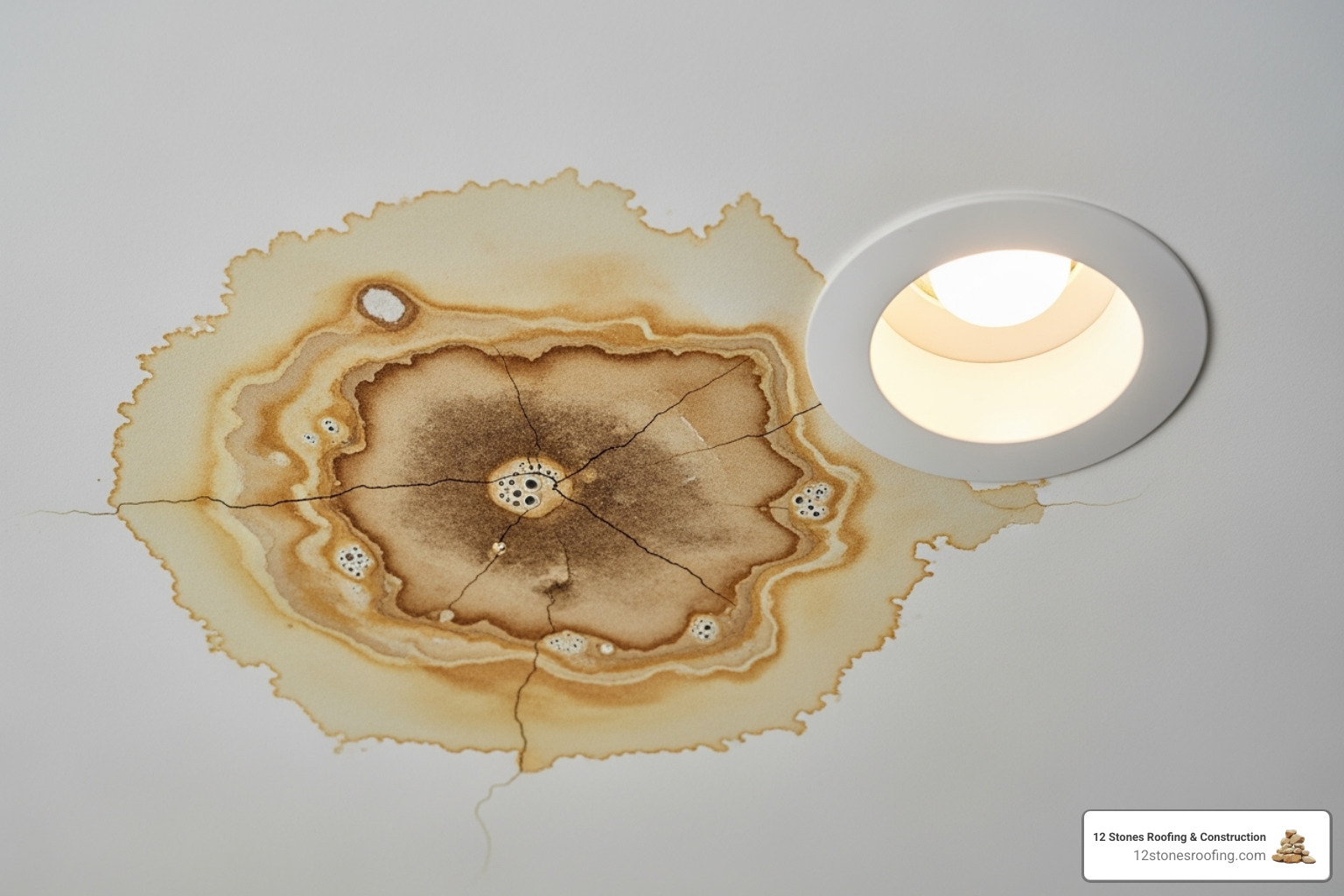
Once hail damage is confirmed, navigating the path to repair requires a clear plan. With the right approach, you can manage the process with confidence.
The High Cost of Inaction: Why You Shouldn’t Ignore Hail Damage
Delaying repairs on what seems like minor hail damage can lead to catastrophic problems. A small breach in your roof’s waterproofing can quickly escalate.
- Progressive Water Leaks: Tiny impacts become gateways for water during the next storm, leading to issues like roof leaks during heavy rain.
- Mold and Mildew Growth: Trapped moisture in your attic and walls creates a breeding ground for mold, posing serious health risks.
- Wood Rot: Constant moisture exposure deteriorates your roof’s decking and rafters, weakening its structural integrity.
- Voided Roof Warranty: Most manufacturers require timely repairs to keep warranties valid. Ignoring damage can void your coverage.
A minor repair today might cost a few hundred dollars, but waiting can lead to a full replacement costing thousands.
Mastering Your Insurance Claim: Documentation and Best Practices
Your homeowners insurance is your strongest ally after a storm. Most policies require reporting damage within a year, but it’s best to act immediately.
- Document Everything: Take clear, dated photos and videos of all visible roof and collateral damage.
- Use Your Inspection Report: The professional report is the cornerstone of your claim, providing expert validation of the damage.
- Meet Filing Deadlines: Know your policy’s deadline and file well in advance.
- Be Present for the Adjuster: Have your roofing contractor meet with the insurance adjuster on-site to ensure all damage is identified and accurately assessed.
- Keep Detailed Records: Document all communication with your insurance company and contractor.
Understanding your policy and being prepared with thorough documentation will help you steer the claims process smoothly and restore your roof to its best condition.
Your Pasadena Hail Damage Experts
The most important question after a hailstorm isn’t if you should call a professional, but when. The answer is always sooner rather than later.
When to Call for an Inspection:
- After any major storm: Hidden damage can exist even if your roof looks fine from the ground.
- If neighbors report damage: Hailstorms don’t skip houses. If your neighbors have damage, you likely do too.
- When you spot collateral damage: Dented gutters or chipped siding are clear signs that your roof was hit.
In Texas, it’s wise to be wary of “storm chasers”—out-of-town contractors who appear after severe weather and often provide subpar work with no warranty. As a local roofing contractor in Pasadena, we are part of this community and our reputation depends on taking care of our neighbors. Choosing local expertise means you get professionals who understand Texas weather, local building codes, and the challenges Gulf Coast homeowners face.
We prioritize safety and provide transparent, reliable service. We’re here to protect your property, and that starts with an honest, thorough hail damage roof inspection. Don’t wait for a small leak to become a big problem. Let our expert roofers in Pasadena give you the peace of mind you deserve.
Frequently Asked Questions about Hail Damage Roof Inspections
Homeowners often have similar questions after a storm. Here are answers to the most common ones we hear.
What size hail can damage a roof?
While hailstones of 1 inch in diameter or larger can cause significant damage to most asphalt shingles, it’s not just about size. A 15-year-old roof with brittle shingles could be damaged by smaller hail that a new roof might withstand. Wind speed is also a major factor; hail driven by strong winds packs a much bigger punch. Metal roofs are more resilient but can show cosmetic denting from smaller stones, while clay tiles can crack from 1-inch hail.
How long do I have to file a hail damage claim?
This is critical. Most homeowner’s insurance policies require you to file a claim within one year of the storm date, but some have shorter windows. Check your specific policy immediately after a storm and don’t assume you have a full year. Delaying can complicate your claim, as adjusters may question whether the damage was from that specific event. We recommend getting a hail damage roof inspection within a few weeks after a storm to get professional, time-stamped documentation.
Will my insurance rates go up if I file a hail claim?
This is a common fear, but filing a single claim for an “Act of God” like a hailstorm typically does not cause your individual premium to increase. Insurance companies raise rates based on the overall risk in a geographic area (like a ZIP code) after widespread storm damage, not on individual claims. The real risk is to your home. Ignoring hail damage can lead to water infiltration, mold, and structural problems that cost far more than any potential rate increase. Don’t let fear prevent you from protecting your biggest investment.
Protect Your Home with a Professional Inspection
A hailstorm may only last a few minutes, but the damage it leaves can quietly compromise your home’s protection for years. The difference between a minor repair and a major financial disaster often comes down to one decision: getting a professional hail damage roof inspection.
The hidden truth about hail damage is that it’s progressive. What starts as a few bruised shingles can evolve into wood rot, mold growth, and structural issues. Your home is your biggest investment; don’t leave its safety to chance. A professional inspection provides the clarity needed to make informed decisions about repairs and insurance claims.
If you’ve experienced a recent storm, now is the time to act. Schedule your free, no-obligation hail damage roof inspection with our expert roofers in Pasadena today and gain the peace of mind you deserve.



